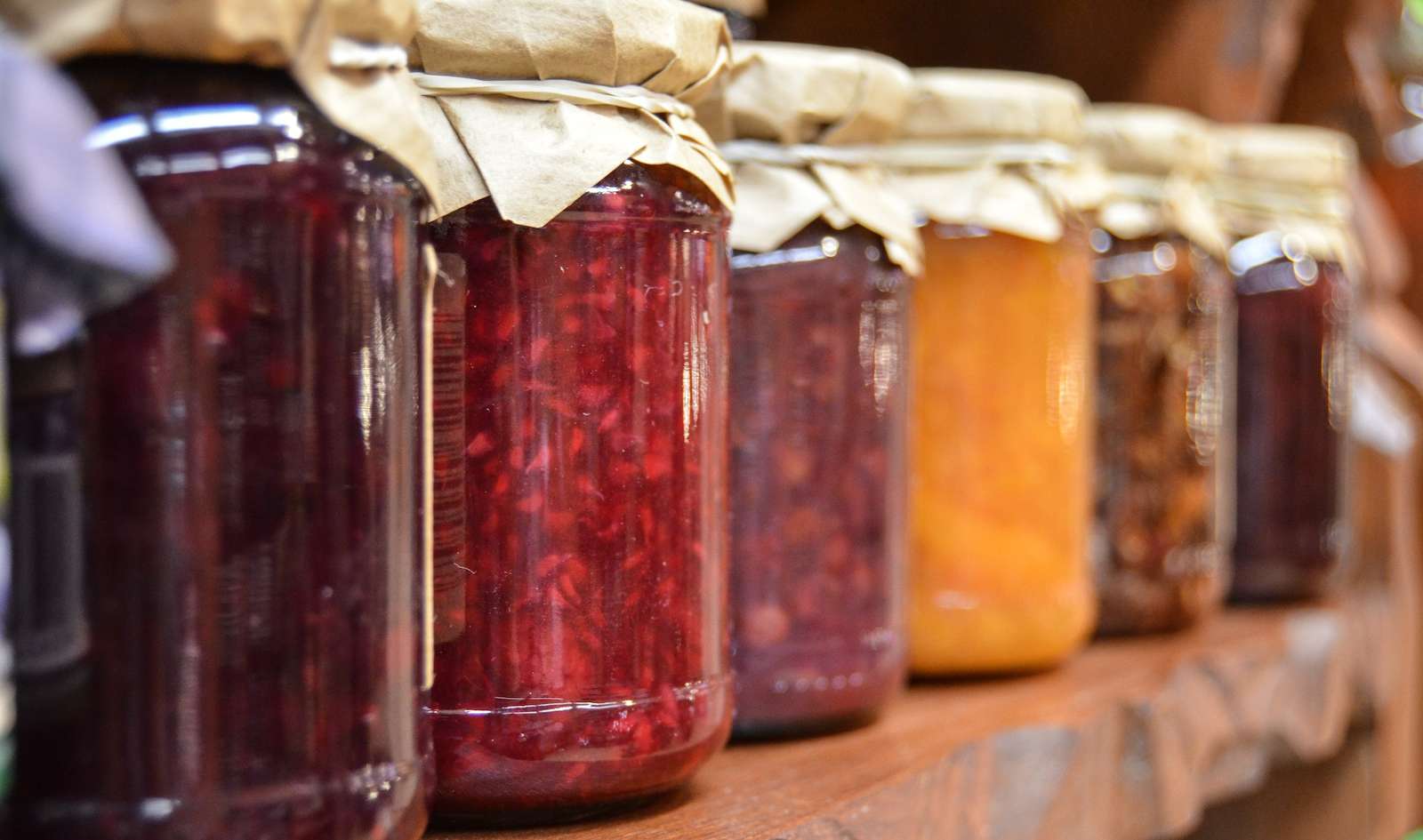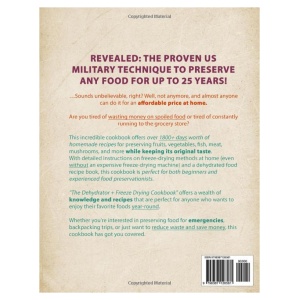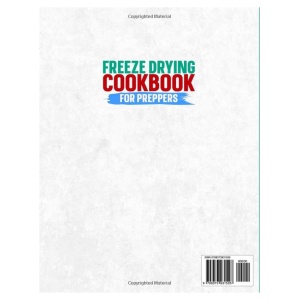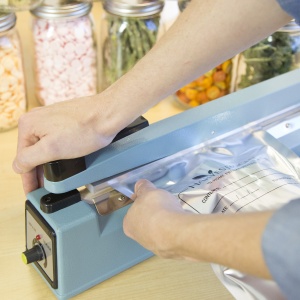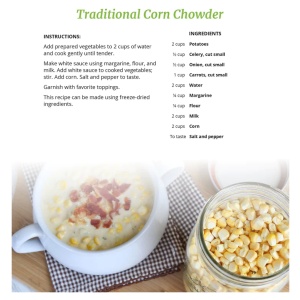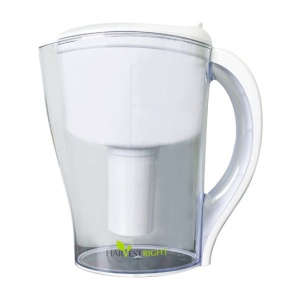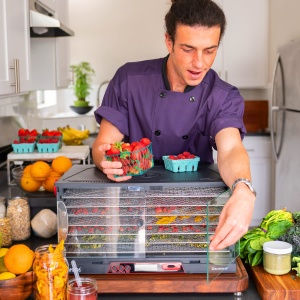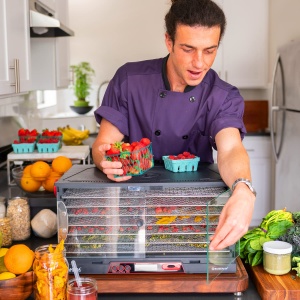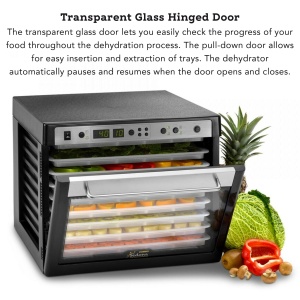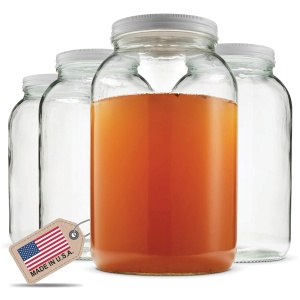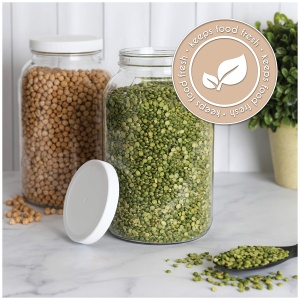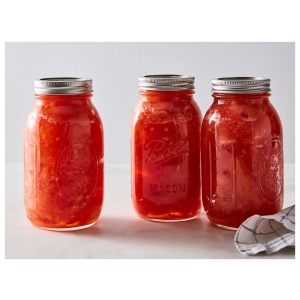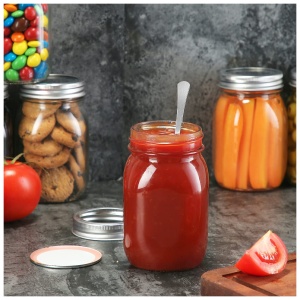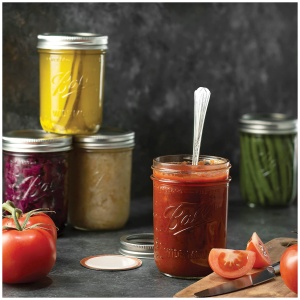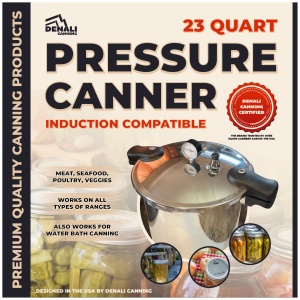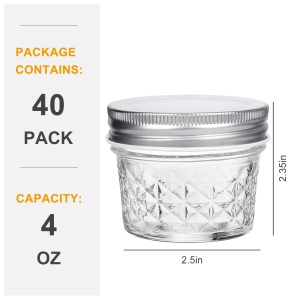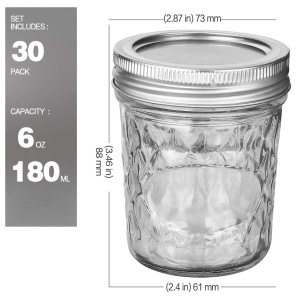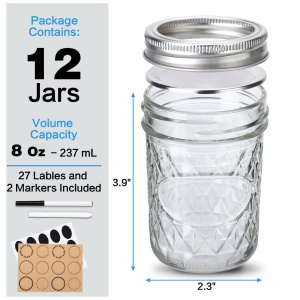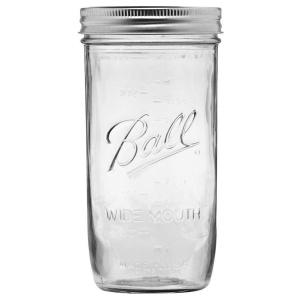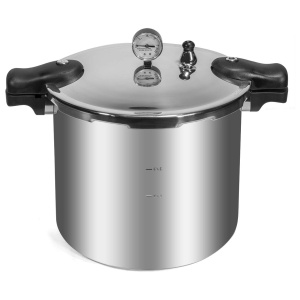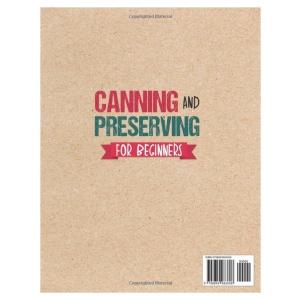In times of unpredictability and emergencies, ensuring a stable and sustainable food supply becomes paramount. Fortunately, there exist natural food preservation methods that can achieve this without resorting to chemicals or refrigeration. In this article, we will explore three highly effective techniques: freeze-drying, dehydrating, and canning, all of which provide extended shelf lives for various food items. These preservation methods offer valuable solutions for emergency preparedness and maintaining food security.
These food storage methods can be done to foods that you’ve grown and harvested/processed yourself or purchased at the store. Many of our customers love to buy chicken breast or other meats in case lot sales to store for the future. The same method applies to fruits and vegetables while they are in season and cheap.
TABLE OF CONTENTS
In this resource we dive into our top three food storage and preservation methods. Click on any to jump to that section of this page to learn and shop:
Food Storage Method 1
Food Preservation Through Freeze Dryers
Freeze-drying, scientifically known as lyophilization, is a sophisticated preservation method that removes moisture from food by subjecting it to freezing temperatures and then placing it in a low-pressure vacuum environment. This process effectively preserves the taste, texture, and nutritional content of the food while significantly extending its shelf life. Notably, freeze-dried foods are remarkably lightweight and ideal for various emergency scenarios, outdoor activities, and long-term storage.
Foods suitable for freeze-drying
a. Fruits: A range of fruits, including strawberries, blueberries, apples, bananas, and mangoes, retain their natural sweetness and nutritional integrity after undergoing freeze-drying.
b. Vegetables: Green beans, peas, corn, carrots, and bell peppers maintain their vibrant colors and distinct flavors through the freeze-drying process.
c. Meats: Freeze-drying enables the preservation of meats such as chicken, beef, and fish, which can later be rehydrated and incorporated into stews, soups, or other culinary applications during emergencies.
d. Dairy: Even dairy products like milk, cheese, and yogurt can be freeze-dried, resulting in convenient, shelf-stable powdered forms.
e. Candies and ice creams: Freeze-dried skittles, big hunks, taffy or ice cream sandwiches, half-baked ben & jerry’s to name a few. Talk about stepping up your food storage game!
The freeze-drying process involves three main stages: freezing, primary drying, and secondary drying. Through a carefully controlled vacuum environment, the frozen food undergoes sublimation, converting ice directly into vapor, leaving behind a dry, stable product with minimal moisture content.
SHOP FREEZE DRYERS
-
2 in 1 Dehydrator & Freeze Drying Cookbook – Paperback – (SHIPS IN 1-2 WEEKS)
$39.99 -
Freeze Drying Cookbook For Preppers: 1500 Days Of Recipes – Paperback – (SHIPS IN 1-2 WEEKS)
$34.99 -
Harvest Right 12″ Impulse Sealer – (SHIPS IN 2-3 WEEKS)
$139.99 -
Harvest Right 3/8″ Hose – (SHIPS IN 2-3 WEEKS)
$32.99 -
Harvest Right 50-Pack 300cc Oxygen Absorbers – (SHIPS IN 2-3 WEEKS)
$23.99 -
Harvest Right 50-pack 6″ x 9.75″ Mylar Bags – 7 Mil Thickness – Heat-Sealable & Ziplock-Resealable – (SHIPS IN 2-3 WEEKS)
$21.99 -
Sale!
Harvest Right 50-Pack Mylar Bags – 7 Mil Thickness – Heat-Sealable – (Multiple Sizes) – (SHIPS IN 2-3 WEEKS)
$25.99 – $32.99 -
Harvest Right Cookbook – Discover Home Freeze Drying with Harvest Right – (SHIPS IN 2-3 WEEKS)
$39.99 -
Harvest Right Freeze Dryer Oil Filter – (SHIPS IN 2-3 WEEKS)
$42.99 -
Harvest Right Freeze Dryer Oil Filter Replacement Cartridges – 3 Pack – (SHIPS IN 2-3 WEEKS)
$26.99 -
Harvest Right Freeze Dryer Oil-Free Vacuum Pump – (SHIPS IN 2-3 WEEKS)
$1,822.99 -
Harvest Right Freeze Dryer Premium Vacuum Pump – Premier Pump – (SHIPS IN 2-3 WEEKS)
$962.99 -
Harvest Right Freeze Dryer Starter Kit – (SHIPS IN 2-3 WEEKS)
$161.99 -
Harvest Right Freeze Dryer Vacuum Pump Oil – 2 Pack – (SHIPS IN 2-3 WEEKS)
$34.99 -
Harvest Right Freeze Dryer XL & L Premium Vacuum Pump – Premier Pump – (SHIPS IN 2-3 WEEKS)
$1,070.99 -
Harvest Right Home Freeze Dryer Silicone Food Molds Set – (SHIPS IN 2-3 WEEKS)
$99.99 – $121.99
Food Storage Method 2
Food Preservation with Dehydrators
Dehydration, a traditional preservation technique, involves the systematic removal of moisture from food to prevent spoilage and microbial growth. Dehydrated foods offer an extended shelf life, maintain their nutritional value, and boast a reduced weight, making them ideal for emergency storage and portability.
Foods suitable for dehydrating
a. Herbs: A variety of herbs, including basil, thyme, rosemary, and oregano, can be dried and stored to enhance flavor profiles in diverse culinary preparations.
b. Fruits: Apples, bananas, grapes, and berries can be sliced and dehydrated, resulting in nutritious and conveniently portable snacks.
c. Vegetables: Dehydrated tomatoes, onions, mushrooms, and zucchini rehydrate well and serve as excellent additions to soups, stews, and sauces during emergencies.
d. Jerky: Thinly sliced beef, turkey, or fish can be marinated and dehydrated to create protein-rich jerky with a prolonged shelf life.
The dehydrating process involves the strategic placement of food on trays, facilitating the controlled circulation of warm air, which gradually removes moisture content. The resulting dehydrated food maintains its integrity, flavor, and nutritional value, making it an essential element of any emergency food supply.
SHOP DEHYDRATORS
-
*Brod & Taylor SAHARA Folding Food Dehydrator – Polypropylene Shelves – (SHIPS IN 1-2 WEEKS)
$328.99 -
*Brod & Taylor SAHARA Folding Food Dehydrator – Stainless Steel Shelves – (SHIPS IN 1-2 WEEKS)
$651.99 -
*COSORI Premium Dehydrator with 6 Stainless Steel Trays in Stainless Steel Silver – (SHIPS IN 1-2 WEEKS)
$237.99 -
*COSORI Premium Food Dehydrator With 6 Stainless Steel Trays – Black Stainless Steel Black – (SHIPS IN 1-2 WEEKS)
$237.99 -
*Excalibur EXC10EL Electric Food Dehydrator 10-Tray, Silver Commercial Dryer – (SHIPS IN 1-2 WEEKS)
$1,627.99 -
*Excalibur RES10 10-Tray Electric Food Dehydrator with Smart Digital Controller With Two Drying Zones – Black – (SHIPS IN 1-2 WEEKS)
$593.99 -
*Magic Mill Food Dehydrator Machine With 10 Stainless Steel Trays – (SHIPS IN 1-2 WEEKS)
$329.99 -
*NutriChef Electric Food Dehydrator Machine – 2000-Watt Premium Multi-Tier Dryer With 20 Shelf Stainless Steel Trays – NCFD20S – (SHIPS IN 1-2 WEEKS)
$987.99 -
*Tribest SD-P9150-B Sedona Combo Digital Food Dehydrator – Black – (SHIPS IN 1-2 WEEKS)
$741.99 -
*Tribest SDE-P6280-B Digital Food Dehydrator – Black – (SHIPS IN 1-2 WEEKS)
$593.99 -
*Tribest SDE-S6780-B Sedona Express, Digital Food Dehydrator with Stainless Steel Trays – (SHIPS IN 1-2 WEEKS)
$906.99 -
*Tribest Sedona SD-P9000 Digitally Controlled Food Dehydrator Large – Black – (SHIPS IN 1-2 WEEKS)
$659.99
Food Storage Method 3
Canning Foods for Preservation
Canning is a time-tested preservation method that involves sealing food in airtight containers to prevent bacterial contamination and spoilage. With two main techniques, water bath canning for high-acid foods and pressure canning for low-acid foods, this preservation method offers versatile options for long-term storage.
Foods suitable for canning
a. Jams and Jellies: Fruits such as berries, peaches, and citrus can be canned into delightful spreads with extended shelf lives.
b. Pickles: Cucumbers, carrots, and beets can be pickled using a vinegar-based brine, resulting in crisp and flavorful pickles for emergency enjoyment.
c. Soups and Stews: Pressure-canned soups and stews containing a medley of vegetables and meats offer convenient and nutritious meal options during emergencies.
d. Tomatoes: Crushed or whole tomatoes can be canned, providing a versatile ingredient base for sauces, salsa, and other culinary creations.
Water bath canning involves immersing filled jars in boiling water to achieve proper sterilization and airtight sealing, while pressure canning ensures the destruction of harmful bacteria like Clostridium botulinum through elevated temperatures. Sealed cans can safely endure extended periods without refrigeration when stored in suitable conditions.
SHOP CANNING SUPPLIES
-
1 Gallon Glass Wide-Mouth Canning Jars with Airtight Metal Lids – 4 Pack – (SHIPS IN 1-2 WEEKS)
$84.99 -
1 Gallon Wide-Mouth Glass Mason Jars for Canning with Airtight Foam Lined Plastic Lids – 4 Pack – (SHIPS IN 1-2 WEEKS)
$76.99 -
12 oz Regular-Mouth Glass Mason Canning Jars – 12 Pack – (SHIPS IN 1-2 WEEKS)
$81.99 -
16 oz Wide-Mouth Glass Canning Mason Jars – 12 Pack – (SHIPS IN 1-2 WEEKS)
$41.99 -
16 oz Wide-Mouth Mason Canning Jars – 5 Pack – (SHIPS IN 1-2 WEEKS)
$40.99 -
2 in 1 Dehydrator & Freeze Drying Cookbook – Paperback – (SHIPS IN 1-2 WEEKS)
$39.99 -
23 Quart Pressure Canner & Cooker – Induction Compatible with Pressure Gauge & Pressure Regulator – (SHIPS IN 1-2 WEEKS)
$263.99 -
4 oz Wide-Mouth Glass Canning Jars with Regular Lid – 40 Pack – (SHIPS IN 1-2 WEEKS)
$45.99 -
6 oz Glass Mason Jars for Canning – 30 Pack – (SHIPS IN 1-2 WEEKS)
$54.99 -
8 oz Regular-Mouth Glass Mason Canning Jars with Airtight Lids – 12 Pack – (SHIPS IN 1-2 WEEKS)
$39.99 -
Amish Canning And Preserving Cookbook: 350+ The Complete Delicious Waterbath Canning And Preserving Recipes – (SHIPS IN 1-2 WEEKS)
$26.99 -
Ball 24 oz Wide-Mouth Glass Mason Canning Jars with Lids and Bands – 9 Pack – (SHIPS IN 1-2 WEEKS)
$82.99 -
Ball 32 oz Glass Regular-Mouth Mason Canning Jars with Lids and Bands – 2 Pack – (SHIPS IN 1-2 WEEKS)
$29.99 -
Barton Pressure Canner 22-Quart Capacity Pressure Cooker Built-in Pressure Gauge with (1) Rack, Aluminum Polished
$158.99 -
Canning and Preserving for Beginners: The Complete Guide – Grandma’s Secrets Revealed – (SHIPS IN 1-2 WEEKS)
$36.99 -
Canning Funnel & Strainer Set for Wide-Mouth & Regular-Mouth Mason Jars – Food Grade Silicone – 4 Pack – (SHIPS IN 1-2 WEEKS)
$29.99
Conclusion & a Joke!
In conclusion, natural food preservation techniques like freeze-drying, dehydrating, and canning offer reliable and chemical-free solutions for extending shelf lives without refrigeration. Mastering these methods allows for the creation of a diverse range of preserved foods, encompassing fruits, vegetables, meats, and dairy products, essential for emergency preparedness and sustained food security. By diligently employing these techniques and storing preserved foods appropriately, individuals can confidently face unforeseen circumstances while maintaining a nutritious and flavorful diet.
And hey, in the spirit of embracing a light-hearted approach, here’s a little joke for y’all:
Why did the tomato turn red?
Because it saw the salad dressing, and just like that, it blushed like a true Southern belle!

